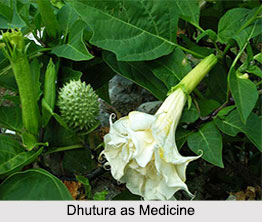 Datura Alba is a poisonous herb used in many Ayurvedic medicines after purification method. Sanskrit writers do not make any distinction in the properties of the two varieties of Datura, and in practice both are indiscriminately used. Sometimes the white flowered variety is specified, as for example in a prescription for insanity.
Datura Alba is a poisonous herb used in many Ayurvedic medicines after purification method. Sanskrit writers do not make any distinction in the properties of the two varieties of Datura, and in practice both are indiscriminately used. Sometimes the white flowered variety is specified, as for example in a prescription for insanity.
Dhutura leaves are used in smoking by debauched devotees and others accustomed to the use of ganja. The seeds are added to the preparations of bhang (leaves of Cannabis sativa) used by natives, for increasing their intoxicating powers.
Health Benefits of Dhatura
The seeds, leaves and roots are all used in medicine. They are considered useful in insanity, fever with catarrhal and cerebral complications, diarrhoea, skin diseases, lice, etc. The smoking of dhatura leaves is prescribed at present both by English and native practitioners in spasmodic asthma.
Dose of Dhatura in Medicine
Svalpajvarankusa: Take mercury, sulphur, aconite, ginger, long pepper and black pepper, each one part, dhutura seeds 2 parts; rub them together with lemon juice and make into 4 grain pills. These pills are used in fever attended with catarrh or cough. Several other preparations of composition similar to the above are in use under the names of Nava Jarankusa, Kalari, Jvarankusa, etc.
The root of Datura alba (svetonmatta) is boiled in milk and this milk is administered with the addition of clarified butter and treacle in insanity. A metallic preparation called Unmadankura rasa and composed of the sulphides of mercury and copper together with a number of other substances and dhatura seeds are also used in this disease.
The fresh juice of the leaves alone or mixed with opium is a common domestic application to inflamed parts. In inflammation of the breasts, a paste composed of turmeric and dhatu fruits is recommended to be applied. An oil prepared in the usual manner with the paste and juice of dhatura leaves, is applied to the head for destroying lice. Another oil is prepared by boiling dhatura seeds and sesamum oil with an alkaline water made from the ashes of Colocasia Indica (manaka) which is used in psoriasis.
Related Articles
Ayurveda
History of Ayurveda
Origin of Ayurveda
Ayurveda Medication
Elements of Ayurveda
Concepts of Ayurveda
Ancient Literature of Ayurveda
Sushruta Samhita
Classification of Medicine




















